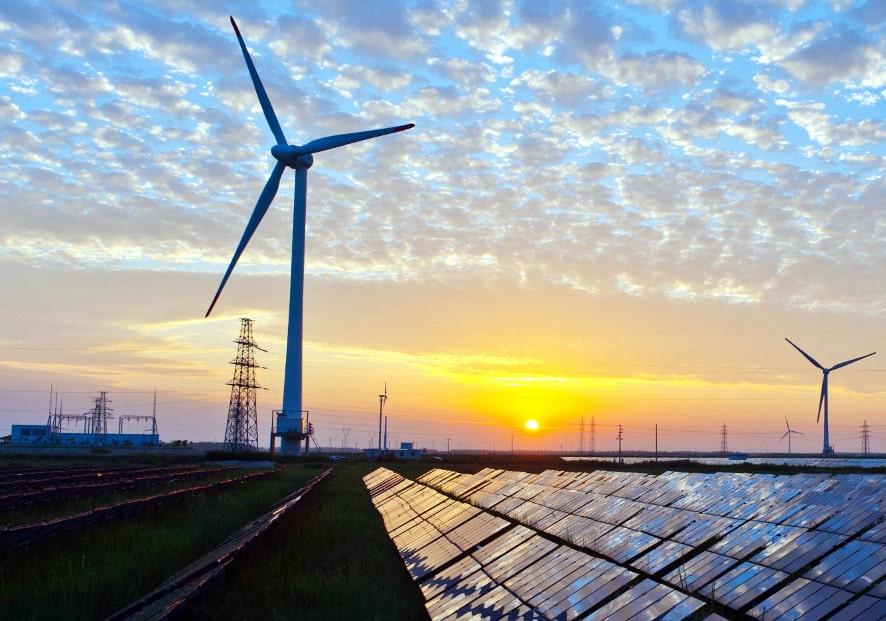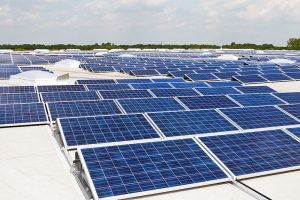
The costs of utilities are ever increasing, and concerns about the environment are reaching a fever pitch. That’s why an increasing number of people are making the switch to renewable energy to power their homes and businesses.
What is renewable energy?
The term renewable energy refers to energy sources that are replenished in nature, such as the energy of the shining sunlight or gusts of wind. Their availability may depend on time of day or year, and weather patterns.[1]
Many people think of renewable energy as a new form of technology, but people have been harnessing nature’s power for transport, heating, and lighting for thousands of years, if not longer. After all, windmills have been grinding grain and wind has been powering sailboats since time immemorial. The sun’s warmth has always kindled fires to warm homes and cook food, and geothermal energy has naturally heated hot springs.
Despite nature’s abundance, humans have instead turned to manmade energy sources over the past 500 years, including coal, oil, and fracked gas. As a result, these resources have become ever cheaper, while so-called renewable energy sources became less common, and therefore more expensive.
Today, more and more people are choosing to capture wind and solar energy, and find more cost-effective ways to use these renewable energy resources.
Different types of renewable energy
There are dozens of different types of renewable energy on the market today.[2] Here, we highlight a few of the most common.
• Solar panels
You’ll find solar power being used in home rooftops, utility-scale farms, and big industry around the world. For proof that solar energy is increasing in popularity, just look to the fact that the world’s total installed photovoltaic panel energy capacity increased by a massive 4,300 per cent between 2007 and 2017! Solar panels convert the sun’s rays to electricity, which householders can use themselves while selling the excess to the local power grid.

• Biomass heating systems
Biomass energy refers to a whole host of biofuels, including ethanol, biodiesel, wood waste, solid waste, and biogas from landfills. Biomass is a flexible power source, and can power vehicles, produce electricity, and heat buildings.
• Heat pumps
Air source heat pumps (ASHPs) are used to absorb heat from the air outside the home.[3] ASHPs can then be heat underfloor heating systems, radiators, and air convectors. Believe it or not, an ASHP can extract heat from the air even when the temperature outside plummets to lows of -15° C.
• Geothermal energy
Countries such as Iceland have used geothermal energy for thousands of years, as it is derived from the internal heat of the Earth. Underground reservoirs of steam and hot water can be harnessed to power deep wells and generate electricity. While geothermal energy is always available (unlike sunlight or wind), it does have a strong sulphur odour (that of rotten eggs) that needs to be managed.
• Wind turbines
People have been harnessing the power of the wind for more than 7,000 years.[4] Electricity-generating wind turbines are becoming more common all over the world, and wind capacity increased more than 22 time between 2001 to 2017, to 539,000 megawatts from 23,900 mw.
• Hydro power
The usage of dams to control river currents and water flow dates back thousands of years. Hydro power is a clean energy source that is constantly replenished by rain and snow.
Advantages of renewable energy
Renewable energy has a number of advantages, some of which are listed below.[5]
- It takes many forms
There are many forms of renewable energy sources that are limitless in their use and scope, unlike the finite resource of fossil fuels.
- It has a lower environmental impact
Renewable energy sources have a lower impact on the environment than fossil fuels. In fact, many renewable energy sources can positively impact the environment.
- It allows for energy independence
In our current paradigm, many countries are forced to rely on others to supply their energy needs. Renewable energy can empower nations to become independent, controlling their own pricing, and even boosting the local economy.
- It helps in the fight against global warming
Traditional energy sources generate carbon dioxide and emissions that pummel the atmosphere, trap heat, and impact the environment and human health.
- It’s easily integrated into daily life
Renewable energy sources are easily implemented into everyday life. Wind farms can be implemented on disused farmland, and solar panels can be installed in nearly any structure.
- It requires low maintenance
Most renewable energy sources require less maintenance, and result in less wastage.
- Renewable energy can save you money
While the cost of setting up some renewable energy sources can be high, the energy sources will pay for themselves over time.
Disadvantages of renewable energy
While renewable energy has many of the aforementioned benefits, it is important to mention some of its disadvantages.
Because they are less common, sources of renewable energy are often more expensive to set up than their more traditional counterparts. It’s also important to note that solar and wind energy rely on what the weather is doing on a particular day and time; if it is not sunny, there will be less solar power.
Critics of wind turbines point to the fact that they are a danger for birds and bats, with some estimates claiming that they kill hundreds of thousands annually. However, this is fewer deaths than are caused by oil spills, and engineers are working hard on ways to make wind turbines safer for flying animals.
Using Renewable Energy in your home
There are plenty of ways that you can implement renewable energy sources in your own home.
- Rooftop Solar Panels
Rooftop solar panels are more popular than ever. Installing photovoltaic (PV) panels on your roof or in your garden will capture the sun’s energy, converting it into usable energy to power your home. The amount of energy you can produce will depend on your latitude, and how you have your panels oriented. PV panels give you the potential to generate more than 10 watts per square foot.[6]
- Underfloor Heating
Efficient underfloor heating systems are often considered the gold standard for heating domestic and commercial properties. Not only does underfloor heating keep your toes toasty warm, it heats your entire home. Warm water is pumped through underfloor pipes, and the heat from the pipes rises to heat the room.
A major benefit of installing underfloor heating? It removes the need for bulky radiators. This makes decorating even easier, is safer for children, and prevents dust and allergens from building up in the coils.
- Wind Turbines
You might think about wind turbines being located on massive wind farms or in clusters floating offshore. But did you know that you can install your own small wind turbine on your own property? It’s true, and it could generate enough energy to power your home. If you choose to install your own wind turbines, remember that some zoning regulations forbid them, and they can be quite noisy.
- Smart thermostats
Smart thermostats connect your heating system to the internet, which allows you to adjust your heating from your smartphone. This prevents wastage if you accidentally leave your heat on during the day, and allows you to heat or cool your home more efficiently.
- A Solar Oven
Some people prefer to start with one or two appliances before making the switch to renewable energy for their entire home. Consider using solar energy to power your oven, saving you a lot of money (and energy). Solar ovens work by trapping sunlight and using it to heat food. While you can buy solar ovens, you can also build your own using cardboard, aluminium, and insulation.
- Hydro Power
Do you have a source of water flowing through your property? If so, you can divert some or all of the stream or river to create hydro electricity to power your home. By running a hydroelectric generator, you can generate electricity for your business or your home. You can buy hydroelectric generators, or, if you’re feeling handy, you could even build one from scratch.
As you can see, there are many different sources of renewable energy that you can harness to power your home. You’ll save money, and lower your environmental footprint to boot.
Reference list
Ampower (2017). Ampower.
Ampower. Available at: https://www.ampoweruk.com/2017/11/advantages-renewable-energy [Accessed 9 Dec. 2019].
BBC Bitesize (n.d.). Pros and cons of renewable energy resources – Generation of electricity – National 4 Physics Revision. [online] BBC Bitesize. Available at: https://www.bbc.co.uk/bitesize/guides/zbsdmp3/revision/4 [Accessed 29 Mar. 2020].
Energy.gov (2019). History of U.S. Wind Energy. [online] Energy.gov. Available at: https://www.energy.gov/eere/wind/history-us-wind-energy
Energy Saving Trust (2018). Air source heat pumps. [online] Energy Saving Trust. Available at: https://energysavingtrust.org.uk/renewable-energy/heat/air-source-heat-pumps.
NRDC (2019). Renewable Energy: The Clean Facts. [online] NRDC. Available at: https://www.nrdc.org/stories/renewable-energy-clean-facts.
Nunez, C. (2019). Renewable energy, explained. [online] Nationalgeographic.com. Available at: https://www.nationalgeographic.com/environment/energy/reference/renewable-energy/.
Thompson, A. (2016). 7 Ways to Power Your Home With Renewable Energy. [online] Popular Mechanics. Available at: https://www.popularmechanics.com/science/energy/g2825/7-ways-to-power-your-home-with-renewable-energy/.
Thompson, A. (2016). Here’s How Much Power You’d Get From Solar Panels on Your Roof.
Popular Mechanics. Available at: https://www.popularmechanics.com/science/energy/a22718/website-predict-renewables-output/ [Accessed 30 Mar. 2020]
Wikipedia Contributors (2019). Solar cooker. [online] Wikipedia. Available at: https://en.wikipedia.org/wiki/Solar_cooker.
[1] https://www.nrdc.org/stories/renewable-energy-clean-facts
[2] https://www.nationalgeographic.com/environment/energy/reference/renewable-energy/
[3] https://energysavingtrust.org.uk/renewable-energy/heat/air-source-heat-pumps
[4] https://www.energy.gov/eere/wind/history-us-wind-energy
[5] https://www.ampoweruk.com/2017/11/advantages-renewable-energy
[6] https://www.popularmechanics.com/science/energy/a22718/website-predict-renewables-output/
